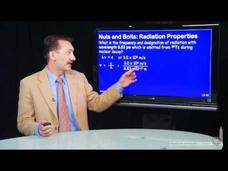Berkeley University of California
Isotopes
Review carbon-12 with the final video in a 15-part series. The video first shows how to use mass spectrum results to determine the molar mass of carbon. It then determines the number of protons, neutrons, and electrons in carbon-12.
Berkeley University of California
Empirical Formula
Let's determine the molecular formula for skunk spray! High schoolers watch a video to learn how to calculate an empirical formula from given masses. The video then demonstrates how to use mass spectrum results to determine a...
Berkeley University of California
Empirical and Molecular Formula
Watch a short and informative video to learn how to distinguish between empirical and molecular formulas. The video also provides some examples of empirical and molecular formulas for hydrocarbons.
Berkeley University of California
Hydrogen Combustion
Burn through a 46-second video to learn about hydrogen combustion. Viewers first learn the definition of a hydrocarbon in the video, and then discover that the products of combustion are water and carbon dioxide.
Berkeley University of California
Relative Atomic and Molecular Mass
Did you know that body armor actually contains uranium? Learn about how isotopes of the same element have different masses and unique physical properties.
Berkeley University of California
Mass Spectrometer
How do mass spectrometers help scientists identify isotopes? The video first describes how mass spectrometers work, both verbally and visually. The video then shows how to use graphs to identify potential isotopes.
Berkeley University of California
Examples of Isotopes
I so hope you'll learn about isotopes. Watch a video to understand that isotopes of an element have the same number of protons but different numbers of neutrons. Then solidify the knowledge by examining examples of hydrogen,...
Berkeley University of California
Atomic Structure
How are atoms structured? Viewers of the video first learn about atoms and atomic structure, including the nucleus and electron shells. The video then describes how atomic numbers and atomic masses are expressed on atomic symbols. You'll...
Berkeley University of California
Conversion Factors 2
A mole of dollars for winning the lottery? The second part of the Conversion Factors video prompts to viewers watch as the instructor converts dollars per second to dollars per year. Now, if we could only win the lottery!
Berkeley University of California
Conversion Factors 1
Converting from moles to number of particles doesn't have to be difficult! Watch as a video briefly explains the concept of conversion factors. It uses a more common conversion of miles to feet as an example to introduce...
Berkeley University of California
Catalysis
Jump-start your understanding of catalysis in chemical reactions. An educational video explains the basic concept of catalysis and its relation to energy. It also introduces platinum plates as a catalyst for the reaction between...
Berkeley University of California
NaCl Formation
Ever wonder how salt forms? Watch as a video instructor adds a solid sample of sodium to chlorine gas to form salt. The video then explains chemistry concepts associated with the reaction.
Berkeley University of California
Relative and Atomic Molecular Mass
Relative molecular masses sure have a lot of decimal places! Watch the video to learn how the number of particles in one mole of carbon-12 determines relative atomic and molecular masses. Viewers also learn how to calculate the...
Berkeley University of California
Stoichiometry
Can you say stoichiometry five times quickly? Watch an informative video to learn the basics of stoichiometry, including how to pronounce it. Viewers also learn the relationship between the number of grams, number of moles, and...
Berkeley University of California
Chemical Reactions
Learn about how chemical reactions require energy to activate and how to draw energy diagrams for chemical reactions. After watching the video, learners discuss why mixing hydrogen and oxygen gas in a balloon won't result in water.
Berkeley University of California
Hydrogen Atom as a Particle in a Box (NB)
How does an electron qualify as a particle in a box? It behaves like a wave and, when bound to an atom, has boundaries. Using this notion, the professor explains a quantum mechanical calculation for a hydrogen atom. Given the length of...
Berkeley University of California
Absorption and Emission Spectra
How does quantization affect absorption and emission? The instructor explains how creating boundaries for a particle that behaves like a wave creates quantization. This is the property that allows for the absorption and emission of...
Berkeley University of California
Particle In a Box-Tube
What happens when you fix the ends of a wave? The video explains the answer by outlining the concept of quantization through a mathematical analysis. The instructor illustrates how only certain wavelengths are possible within a specific...
Berkeley University of California
Photoelectrons
How much energy does it take for an electron jump from chromium metal? Using a formula, the instructor describes the procedure for determining the wavelength of light needed for a specific metal to eject electrons.
Berkeley University of California
Light Wave-Particle Duality
How can light be both a wave and particle? A video explains the co-existing wave and particle nature of light. Using formulas discussed in previous lessons in the series, the instructor develops the formula that shows the...
Berkeley University of California
Photoelectric Effect-Tennis Ball
Different light has different energy! An informative video describes the photoelectric effect by describing the result of different wavelengths of light hitting metal. The instructor describes the threshold of releasing electrons as...
Berkeley University of California
Light Intensity-Geiger Counter
Light can be broken down into particles similar to atoms! The instructor in the video uses a thought experiment to describe the process of breaking down light into particles and introduces the energy of a photon formula. He then uses a...
Berkeley University of California
Electromagnetic Spectrum
Light waves are not equal. The video introduces the electromagnetic spectrum and describes the progression of the wavelength. It also highlights the visible light spectrum.
Berkeley University of California
Radiation Properties
How are the wavelength, frequency, and speed of a wave related? The instructor in the video explains the process of determining the frequency of a wave with a known speed and wavelength. The wave is then classified along the...























